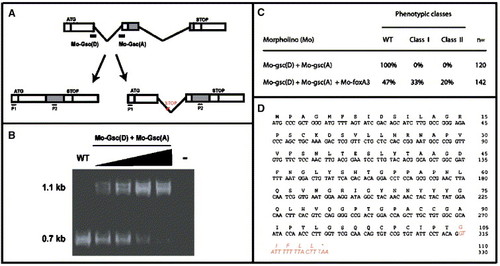Fig. 3
- ID
- ZDB-FIG-070912-34
- Publication
- Seiliez et al., 2006 - FoxA3 and goosecoid promote anterior neural fate through inhibition of Wnt8a activity before the onset of gastrulation
- Other Figures
- All Figure Page
- Back to All Figure Page
|
Maternal and zygotic contribution of gsc in the headless phenotype. (A) Correct and aberrant splicing of zygotic gsc pre-mRNA in the presence of morpholinos directed against the donor, Mo-gsc (D), and the acceptor, Mo-gsc (A), of splice of the first intron of the gsc gene. Exons are boxed, homeobox is in grey. P1 and P2, forward and reverse primers used for RT-PCR analysis of injected embryos. (B) RT-PCR analysis of progressive inhibition of the splicing of gsc first intron in embryos injected with a range of Mo-gsc (D) and Mo-gsc (A). The numbers on the left indicate the size of the RT-PCR products representing the aberrantly (1.1 kb) and correctly (0.7 kb) spliced RNAs. Lane 1, non-injected wild-type embryos; lanes 2–5, embryos injected with 0.6 pg, 1.2 pg, 2.5 pg and 5 pg of each morpholino, respectively; lane 6, reverse transcriptase free negative control. (C) Frequency of class I and class II phenotypes analyzed at 24 hpf in Mo-gsc (D) plus Mo-gsc (A) injected embryos (5 pg each Mo) and in embryos with an additional injection of Mo-foxA3 (10 pg). (D) Nucleic and amino acid sequence of gsc fragment generated from the aberrant splicing. Intronic region is shown in red and italic. Star indicates the stop codon. |
Reprinted from Developmental Biology, 290(1), Seiliez, I., Thisse, B., and Thisse, C., FoxA3 and goosecoid promote anterior neural fate through inhibition of Wnt8a activity before the onset of gastrulation, 152-163, Copyright (2006) with permission from Elsevier. Full text @ Dev. Biol.

